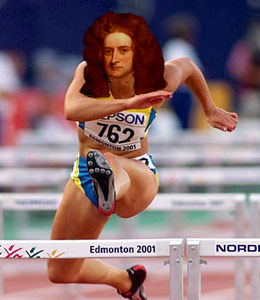
Track and Field
The Boring Stuff
or Things to Know Before You Start
Tracey Kobayashi
50 Phelan Ave, NGYM
San Francisco, CA 94112
(415)452-7311
tkobayas@ccsf.edu
PE 9A: Fit or Fat
College & Career Ed
PE 50: Fitness Center

IM Me!
AIM - TKatCCSF
Yahoo - tkobico
ICQ - 155909399
Updated by Tracey 15 August 2001
Track & Field page |
Intro
Sprinting |
Long Jump |
High Jump
Javelin
Track & Field is a series of running, jumping and throwing events, each highlighting different aspects of strength, power, speed and endurance. Participants may compete, as individuals or part of a team, in one or several of these events during the course of a meet.
You're probably disappointed right now because you came to this class to throw lethal weapons and play in the sand, but trust me, this segment is short AND necessary. You don't want to walk into a situation without a good idea of the hows, whys and wherefores, and this course should be no exception for you. So why is this important? Every motion we make is governed by three little facts known as...
Newton's Laws
or - How and Why Things Do What They Do.

- Inertia
A body continues in its initial state of rest or motion with uniform velocity unless acted on by an external force. - Acceleration
A body's acceleration is inversely proportonal to its mass and directly proportional to the resultant force acting on it. - Action/Reaction
Forces occur in pairs, each acting in opposition to each-other.
Nit-Picking. Coaches often use the term centrifugal force when they speak of nonlinear motion. Although this is rather nit-picky on my part, they really mean centripetal force, an unbalanced force that results in a change in the direction of velocity of a particle or entity. If we think about a discus thrower spinning in the circle, at any point in time, the discus has tangential velocity, but the unbalanced force of the thrower's hand accelerates the disc towards his or her body, thereby preventing the disc from staying on its linear path (until release, that is).
I will give examples of how these principles apply to different events in class. Until then, think about what you believe to be proper sprinting mechanics, and try to use Newton's Laws as proofs for your theories.
Track & Field page |
Intro
Sprinting |
Long Jump |
High Jump
Javelin